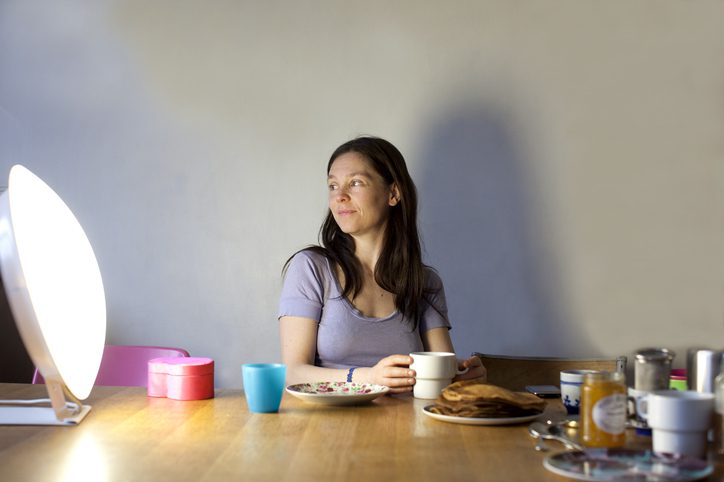As winter approaches, you may feel more down and out than usual. This could be due to a condition known as seasonal affective disorder (SAD). Below, we’ll cover what SAD is, potential causes and symptoms to help you take preventative action or seek treatment.
What Is SAD?
SAD is a type of depression. It typically occurs at the same time each year, often during the fall and winter seasons when there’s less natural sunlight.
Seasonal affective disorder impacts up to 3% of the general population. And as Johns Hopkins Medicine reports, it can increase with age.
SAD isn’t limited to the winter months, either: It’s less common, but some people experience the condition in the spring and summer.
What Causes SAD?
According to Johns Hopkins, while research hasn’t identified a direct cause of the disorder, it may be linked to vitamin D deficiency, a condition that puts older adults at risk for health issues such as diabetes, cancer, heart disease and overall poor health. Research shows that many people with the condition also have reduced serotonin activity and/or excessive melatonin production. This can make it difficult to adapt to changing daylight hours throughout the seasons.
Daylight savings time can affect how you feel during the winter. When daylight savings time ends, less sunlight means less opportunity for the body to produce vitamin D and encourage serotonin activity. This can exacerbate symptoms of seasonal affective disorder, especially in northern parts of the world with less winter daylight and more days of gray.

What’s the Difference Between SAD and Depression?
Both SAD and depression can cause similar symptoms, but they aren’t exactly the same.
SAD occurs in response to a change in seasons. Symptoms can also vary depending on the severity of the season; people in milder climates may be less likely to experience severe SAD.
Depression, meanwhile, isn’t tied to the seasons. It’s linked to various factors including genetic predisposition and life stressors.
Symptoms of depression can include feelings of sadness, loss of interest in activities and difficulty sleeping, regardless of the time of year.
Signs and Symptoms of SAD
If you notice that your mood has changed and you’re feeling down during a seasonal shift, it could be a sign of SAD. Symptoms include feeling sad, hopeless, anxious and tired, fatigued or low energy.
According to the National Institute of Mental Health, other common symptoms include:
- Feeling stressed
- Trouble sleeping or oversleeping
- Loss of interest in activities you used to enjoy
- Difficulty concentrating
- Withdrawing from social activity
Some SAD symptoms, such as trouble sleeping or memory and concentration difficulties, can correspond to physical and lifestyle changes associated with aging, too.
If you are experiencing any of these symptoms, know you are not alone. Take comfort in sharing with your loved ones and seek help from your doctor or a mental health professional. They can help you determine if you have SAD and discuss the treatment options available.
Diagnosing and Treating SAD
A doctor can diagnose SAD by assessing your symptoms. They may also ask if you have a family history of depression or other mental health conditions. Sometimes, a doctor may recommend a physical exam to rule out other health conditions.
Fortunately, there are several treatment options to help ease symptoms. These are some of the most common treatments., but as always, ask your doctor if these methods will help with your specific case.
Light therapy
Light therapy involves exposure to artificial light for a set period each day. Studies show this can help improve your mood and energy levels and decrease symptoms. These have become more accessible over the years and can even be found on Amazon.

Antidepressants
Your doctor may prescribe antidepressants to help ease the symptoms of SAD. This could include a prescription for a selective serotonin reuptake inhibitor (SSRI) such as fluoxetine, citalopram, sertraline, paroxetine or escitalopram.
Psychotherapy
Talking with a therapist can help you understand and manage your thoughts and feelings. Cognitive behavioral therapy (CBT) is one form of therapy used to treat SAD. CBT helps people identify negative thinking patterns and learn how to change negative thoughts and behaviors. This can help you feel better during the winter months.
Exercise
Studies show that regular exercise can help improve your mood and energy levels, and help you sleep better at night, which could help with SAD symptoms. So look for ways to get moving, indoors or outside: Just 30 minutes each day can help improve your mental and physical well-being.
Need some inspiration? Some exercise ideas include:
- Taking a brisk walk outdoors and enjoying the fresh air (just be sure to bundle up if the temperatures are dropping!).
- Dancing, whether you stream a Zumba class online or just put on your favorite record.
- Taking a family bike ride.
- Utilizing local fitness center amenities, like a pool or yoga class. Some outdoor exercises include walking, biking, swimming, and yoga. During the winter, make sure you have the right equipment and clothing for outdoor activities. As always, get the go-ahead from your healthcare provider before starting a new exercise or sport.
Tip: If you’re 65 or older and have a Medicare Advantage or another health insurance plan, you may be able to work out for free as a SilverSneakers member at participating fitness centers. SilverSneakers members can also access hundreds of nutrition videos and virtual exercise classes, like chair yoga, if you’re working out from home or have limited mobility.
Combat SAD This Season
If you think you may have SAD, talk to your doctor to learn about the treatment options. You don’t have to manage your symptoms alone. Treatments can help ease symptoms if SAD strikes.
This informational material shall not be considered medical or health advice. You should always consult your health care provider before changing your diet or starting a new exercise regimen. The Hartford assumes no responsibility for any decisions related to your medical or health care. Consult with your health care provider, nutritionist, or other health professional before making any decisions that may impact your health and well-being.







This is exactly what I was experiencing!!Thank you for your advice.
I found this article very helpful. I walk 2 to 4 miles a day and that really helps. I am going to start getting up earlier, so I have more access to light.
My sister and I are self-diagnosed SAD victims. We are both on Antidepressants but none-the-less BOTH start dreading it in early October. Once the clocks Fall-Back an hour in early November, symptoms worsen immensely! Sleep is difficult, forgetfulness and loss of thought processes ensue. Aches and pains are magnified! I was widowed early last year and have been more isolated since then to begin with. Being a New Englander makes it worse! I appreciate the suggestion of Artificial Light daily, and will see if that may lift my spirits this year!! I’ve been taking Vitamin D for years, doesn’t seem to help at all-or perhaps it would be even WORSE without it! Thank you for the information!! Loss of appetite is another related plague!
Found this article and definitely want to hear more, I do have light therapy and am getting it ready for this season, look forward to seeing more articles.